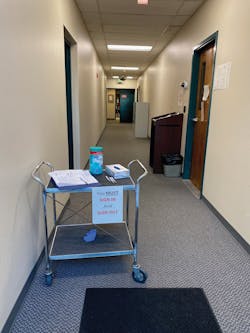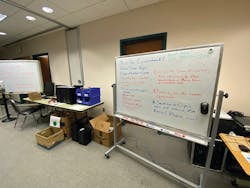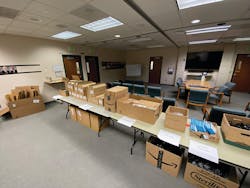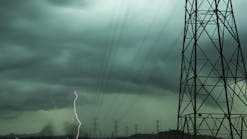When severe weather strikes, linemen are prepared to restore power and rebuild infrastructure. Recently, however, utilities faced a new type of emergency response due to the COVID-19 pandemic.
As critical infrastructure workers, linemen were required to continue working in the field to get the job done. Meanwhile, utilities were tasked with finding ways to safeguard their field workforce and keep the lights on.
For example, in the state of Washington, which had 3,723 cases of coronavirus and 175 deaths as of March 27, one utility was able to get an early jump on its response to the pandemic. In early March, employees for Grant County, Washington, Public Utility District (Grant PUD) came into contact with a consultant thought to have the novel coronavirus. Although the test turned out to be a false positive, the situation triggered an order to activate the utility’s incident command center.
“The COVID-19 response has been rapid and extreme,” says Derin Bluhm, chief technology officer for Grant PUD. “In a pandemic, the direct risk isn’t to the infrastructure as it is in a wildfire or natural disaster. What’s at risk is the availability of the people to get the work done and the ability to keep up under changed processes. Having been hit early with a COVID-19 threat, we’re improvising and learning new protocols, and maybe what we’re learning could help other utilities.”
Dispatching Work Orders
With a two-week head start in implementing its incidence response plan, Grant PUD implemented technology for facilitating remote work and adapted other technologies to help people digitally distribute work to the field. Rather than meeting crews in person to assign work and sort out resource challenges, the utility devised an alternate approach. Grant PUD recently deployed the ARCOS Mobile Workbench product to enable crews to accept trouble ticket work on their mobile devices while in the field.
This system replaced the utility’s old fax-based system, which required crews to come into the service centers to pick up work orders. The COVID-19 response required rapid expansion to assign all types of field work.
Moving forward, supervisors, customer service and dispatch now create tickets and have them sent directly to selected crews in the field based on availability, proximity, skillsets and readiness. Crews can then update the tickets and mark completion with any notes to ensure job status is immediately updated, which allows the crew to accept the next assignment. This approach allowed the utility to enforce key social distancing requirements and still deploy work to crews, reducing risk to crews, supervisors and staff of potential exposure to an unknowingly ill, but still contagious, individual.
Social Distancing and Sanitizing
To adhere to the social distancing recommendations, Grant PUD crews took separate vehicles to job sites. Many used pool vehicles, which were no longer needed for office workers, as transportation. The utility also placed physical barriers and tape to provide visual cues for safe separation distances both in the field, at the warehouse and at the technology service desk.
During the COVID-19 outbreak, all facilities required workers to sign in and sign out. That way, Grant PUD could monitor who entered the building, where they went and when they left. If they were later discovered to be ill after coming to a facility, the staff could properly clean and potentially isolate specific areas.
In addition, the company implemented a policy requiring at least 6 ft of separation at all times in office environments and whenever possible in the field. Where law required two persons in a bucket for safety, crews wore N95 respirators and minimized direct contact aligning to OSHA guidelines that soon followed. Care was taken to sanitize the work area each shift and crews moved to a weekly rotation to reduce likelihood of virus spread between crews.
Working from Home
During the COVID-19 epidemic, all non-essential workers worked remotely. Grant PUD allowed workers to take their entire workstation, laptop bases, keyboards, mice and monitors home. To make them feel more comfortable working from home, Grant PUD recently delivered the employees’ office chairs to their homes (following distancing and hygiene protocols) to provide better ergonomics.
To provide proper sanitation, Grant PUD implemented “one-touch” processes for equipment check out, which included a wipe-down of all office equipment during the check-out process. All equipment was already encrypted for information security, and the company was willing to accept some level of equipment loss or damage to rapidly enable work-from-home capabilities. Because employees already signed chain-of-custody forms for received IT assets, no further forms were needed.
Grant PUD is a wholesaler and provider of an open access network with gigabit fiber connectivity throughout most of Grant County. As such, its employees were able to take advantage of this fast Internet connectivity while remoting in from company-owned equipment via VPN. In addition, they could use Microsoft Teams and OneDrive for access from any connected device and access Citrix from any non-company owned device. All remote access required multi-factor authentication.
Employees were expected to use MS Teams for meetings and to be available during business hours. If desired, they could join after work virtual happy hours to stay personally connected while physically isolated.
To further support employees working from home, Grant PUD formalized short-term reimbursement to ensure employees didn’t carry any additional costs. The utility posted all information for employees to its blog page and mapped documents and chat into its IT support team’s site setup to help employees to transition to remote work.
Handling Material Logistics
In addition to helping its employees to seamlessly make the transition from working in the office to working at home, Grant County PUD was tasked with devising a method for handling deliveries in the warehouse. From the beginning, the utility tried to scale back warehousing work to implement “physical distancing measures.” Because the gates were initially locked, third-party delivery companies sometimes tossed boxes over the fence to complete their deliveries.
To address this challenge, the utility opted to keep the warehouses on Grant PUD’s footprint open as much as possible to supply field workers with the necessary materials. Due to COVID-19, the utility required boxes to be opened with gloves, which were then thrown away to handle the contents. Per Centers for Disease Control and Prevention (CDC) guidelines, they kept deliveries untouched and sequestered for 24 to 48 hours to mitigate the transmission of the novel coronavirus.
When Grant PUD initiated its pandemic response plan, the utility closed all facilities except for critical employees. The company immediately realized that the warehouse and materials handling functions were essential to supporting the work performed by crews and other critical staff. For example, technology service desk personnel were dependent upon shipments of hardware to support the work-from-home directive to office staff.
“That awareness required that we develop distancing and hygiene protocols for everyone involved in the warehouse/materials handling functions, physical security and the crews,” Bluhm says.
By working quickly to respond to the worldwide pandemic, Grant PUD was not caught flat-footed by COVID-19. Instead, the Washington utility was able to swiftly and successfully protect its field and office workforce while keeping the electricity flowing to its customers.





